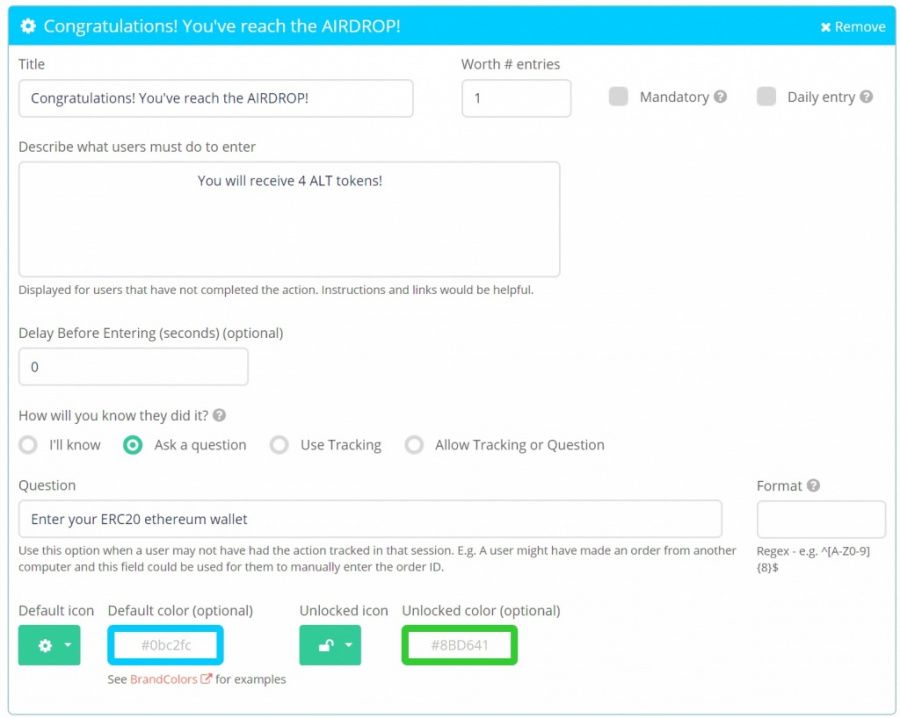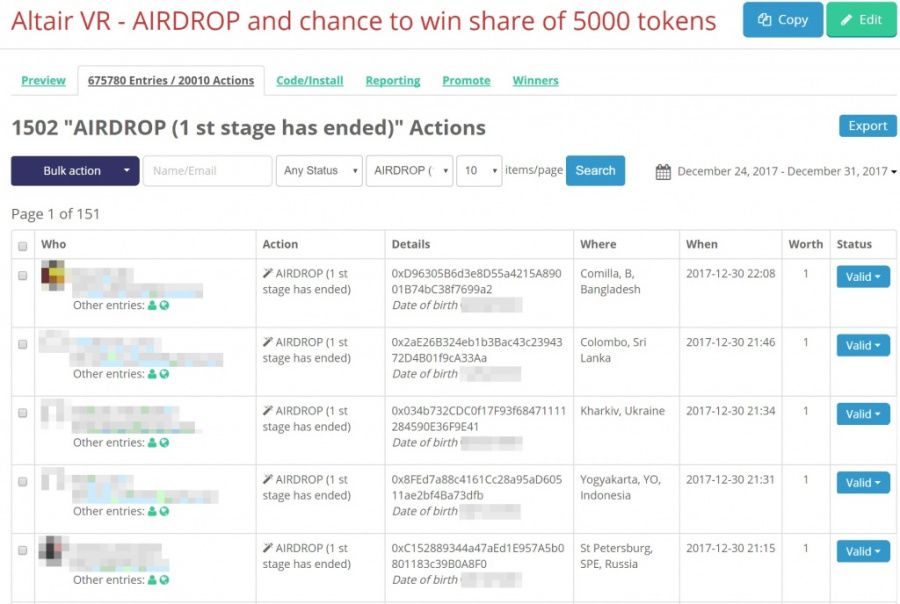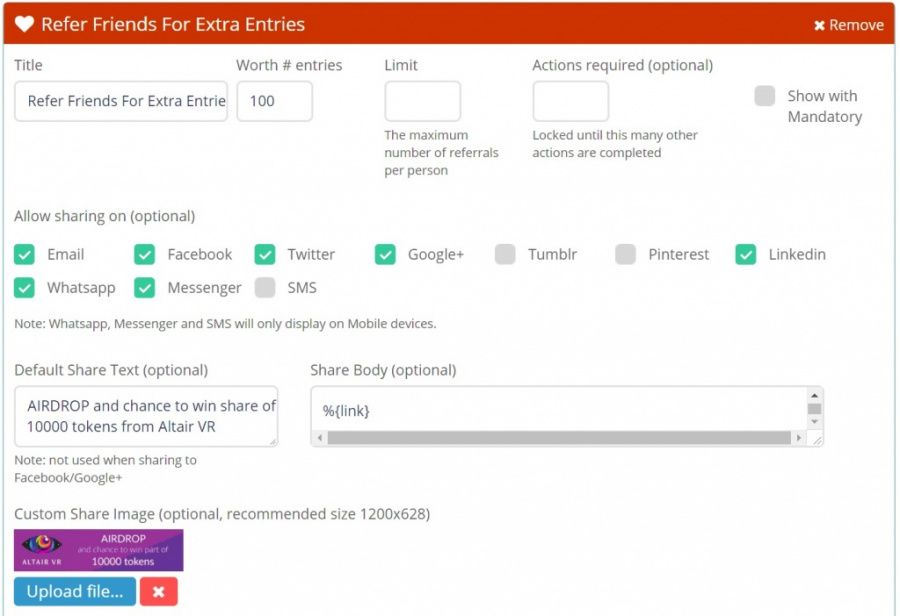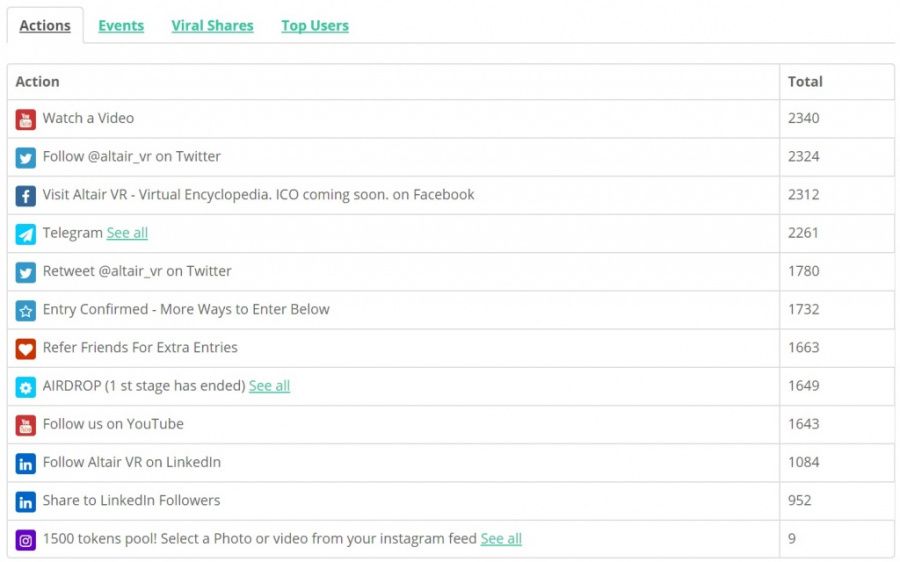How to do an AIRDROP for 1500 people in two nights spending $149
I’d like to present a useful case describing how to organize a quick and cheap DIY airdrop, get 1500 participants all around the globe in just one week, get a huge increase in one’s audience on Facebook, Twitter, and other channels, and add considerable momentum to the bounty campaign ass well. This will be interesting, most of all, to companies planning an ICO but also it can be used in promotion of traditional services.
What It Gave Us
Some interim results of the ALTAIR VR airdrop after 18 days (40 more days left):
- 1500 participants completed the airdrop tasks
- 2585 participants registered for the competition to win 5000 tokens
- 1697 out of those used referral links
- 20010 project promotion tasks were completed by the participants
- 1500 to 2700 - increase in our social media channels audience
- 1300 - increase in the number of our bounty campaign participants
- 17060 visitors of the official website (it’s not only because of airdrop, for sure)
- 252 investment requests
Resources spent: $149 and two nights of work.
Background
In December, I had to start thinking seriously about the upcoming bounty campaign. I’m used to getting to the bottom of matters, so I quickly realized that we had two main options: pay for automated campaign services or do it all ourselves. Since we are using our own funds to organize the token sale, so that we try to study all parts of the process and use the DIY approach whenever possible. It took me 5 days to design the bounty campaign, and once it was launched, we started getting requests right away, but they were very few.
Searching for a solution and researching other people's experience, I got the idea to do an airdrop - a free distribution of tokens to all those who register.
Airdrops are generally considered as a pretty useless tool, since it mostly attracts freeloaders that cannot do anything for the project apart from increasing the public interest for a while. I guess that’s why there is so little info online on how to do an airdrop except for different Google form versions; there seem to be no automated solutions. A Google form was not a great option, either because I didn’t just want to distribute free tokens but rather gain some benefits for our project.
About Gleam
I had to get creative. Once, last summer, I saw how a good ICO project was doing a token draw via the service gleam.io. It’s a powerful tool for promoting digital goods and services, known in Russia primarily as a way to get Steam games for free. So, after spending two days studying gleam, I realized that it was suited my task perfectly and (!) could help me make a useful airdrop.
Gleam is mostly designed for competitions: it allows you to create simple tasks for users, most of which can be tracked automatically - for instance, to subscribe to a Twitter or YouTube channel, to visit a Facebook page, etc.

For each action, you award a participant with a certain number of points (entries), once the task is completed. There can be many different tasks, and each earned entry is a chance to win a prize. Thus, it is in the user’s interest to complete all the tasks. The monthly subscription to the service (using your own corporate style and located on your domain) costs $149.
Adding Gleam to your site is very easy, actually: you create a page, Gleam gives you an html code that you have to embed in it, and their widget appears on the page. Easy peasy.
Airdrop
I would like to tell what I used for my campaign and how I did it.
For me, the whole airdrop thing had to satisfy several options:
1) The user had to do something in order to earn free tokens (yes, I know it differs from the classic airdrop model, but it allows to obtain some tangible benefit for the project).
2) Such actions had to be as simple as possible, otherwise many would give up.
3) The completion of tasks had to be tracked and verified.
4) After the tasks were completed, we had to get the user’s ETH wallet address to transfer the tokens.
5) The number of participants had to be limited up to 1500.
I chose the Competition campaign option, which implies a prize draw between the participants and where the number of entries increases one’s chances to win. Above the list of tasks I placed a button with a CTA - to participate in the main part of the bounty campaign and get even more free tokens.
Here are the tasks that the airdrop participants could complete:
1. Subscribe to our Telegram channel - 50 entries
2. Subscribe to our Twitter - 20 entries
3. Subscribe to the YouTube channel - 20 entries
4. Visit our Facebook page - 20 entries.
Facebook and Instagram don’t seem to like Gleam much, so you cannot offer a user to join the group or like a page, but you can do the rest. Tracking the actions no. 2, 3, and 4 is done automatically, but it’s kind of strange the service has no idea what Telegram is, so I had to create a custom task with a link to our Telegram channel. The system provides several options for monitoring task completion manually, such as asking users questions. So I decided to ask users to provide their nicknames and threatened to annul their entry score if they unsubscribed from our Telegram channel before the competition was finished. It worked for most, though not for all.


In order to get their airdrop tokens, a user had to complete all 4 tasks. Thus, I checked the Mandatory box, which makes the tasks, well, mandatory, before a user can move forward. Only after that users are asked to provide their ETH wallet address to receive the tokens. Essentially, once the address is provided, their airdrop participation is considered successful. For this task, I have set the minimum score of just 1 entry; in order for it not to influence the overall score too much, I had to set the scores for other tasks at 20 entries and more. You can also choose other values, like 10 entries or 100, it doesn’t matter; people like big numbers, that’s all.

After that, all I had to do is monitor the number of airdrop participants from my admin account in order to stop it at 1500 users. I decided that was enough for the first part of my experiment, though Gleam itself has no limitations on the participant numbers. The service allows to see reports on every task separately; the only one inconvenience of doing an airdrop on Gelam is that monitoring has to be done manually. Here’s what the admin area looks like.

How I Almost Got Everyone Upset
Since the primary use of Gleam is competitions, it was logical to hold a competition of some sort. Simple tasks are great, but you can offer users to do even more for the project.
I also had to choose the right duration for the competition. I thought that 2 months would be best, since a month and a half was left till the start of the pre-ICO. However, here’s the trick: the competition would go on for two months, but the airdrop had to be stopped once the necessary number of participants had signed up. So once I saw that I had 1500, I deleted the part on the airdrop from the list. As it turned out, at that moment all records of users had completed the airdrop suddenly disappeared from the admin area! I think this is the lack number three of Gleam. Luckily, the records could be restored via the tech support: I had to create a similar task (in our case, a custom one) and ask the support to transfer the records from the deleted task to the new one.
Competition
Airdrops attract lots of freeloaders, but if you want to achieve an explosion of visitor numbers, you need an affiliate (referral) program. Gleam lets you add one in just a few clicks - here’s what it looks like:

You can choose your settings to let users share the invitation on any social networks, limit the number of referees (which I decided not to do), or make the referral program available only after some other tasks are completed - I decided not to trouble the participants with that, either. I set the number of entries that a participant could earn for each successful referral at 100 - more than for any other sharing action.
I posted the airdrop and competition announcement on Bitcointalk and in all our social media accounts, and just 12 hours later the referral program was already in full swing - huge numbers of people were registering. At present, we have a participant who has already brought us 147 new users, which is over 5% of the total number of participants.
The motivation to invite new people is to increase one’s chances to win prizes. As for the prizes, there are 10 packages of 500 tokens each (1.25 ETH in the ICO equivalent). The service itself can choose winners in partnership with random.org; you can choose winners once in a certain period of time - every week, for instance; you can do it manually if the competition requires creativity, etc.
Creative Competition
Once I saw this option, I decided to add a creative competition, too, allocating 3 prizes out of 10 for it. Our team would choose winners, and the number of entries awarded for this task was the highest - 200 points. As you may remember, the number of entries collected influences your chances to win one of the main prizes.
I offered users to post photos or videos on Instagram wishing good things to our project, with the hashtag #altairvr2018. The system reads hashtags automatically, so photos without hashtags are ignored. The terms were to write a wish on a sheet of paper and take a selfie or a video holding it.

I thought that it would be fun to collect selfies from around the world right before the New Year; unfortunately, the idea has failed miserably. Up to this point, 170 users have taken part, and only 9 pictures satisfy the conditions, in spite of the high entry score and specially allocated prizes. Conclusion - freeloaders don’t like to appear in photos; moreover, it is better not to mix different competition concepts in one place. But the goal was simple - to check which ideas work better; and I got some valuable experience out of this.
Stats
Perhaps some will be interested in the interim stats. While the airdrop was in progress, people completed tons of tasks almost without thinking, knowing they were guaranteed to get some tokens for that. Peaks in visitor numbers were related to posts by active users looking for referees. For example, one popular bounty hunter posted the following on his Twitter page on January 5:

And here are some figures showing which tasks were more popular with the participants.

At some point I switched the task from subscribing to the YouTube channel to watching a video among the first four obligatory tasks, and this task became the leader. The AIRDROP item was absent for over a week after I had deleted it, and I restored it a couple of days ago, so it has few users so far. Linkedin is clearly among the losers - not only because it is blocked in Russia (it doesn’t have a huge audience in Russia anyway), but probably because the Linkedin audience does not generally participate in such competitions.
You can change tasks throughout the duration of the competition, add new ones, change the number of entries awarded, and so on. It does not affect the entry points already earned by users. However, it is better not to delete tasks, since, as I have pointed out before, all the stats and records will be automatically deleted.
Conclusions
1. The main conclusion is that an airdrop can be very useful when used intelligently and not just as a way to distribute tokens for free.
2. Tasks that take less than a minute to complete are perceived as a freeload.
3. People who go airdrop hunting are usually the same who participate in bounty campaigns, so it is a good way to attract attention to your bounty.
4. A referral program is an essential feature of a successful airdrop.
5. Competition tasks should be easy and not require any creativity.
Next, we will launch a second wave of our airdrop, revising the list of tasks based on our newly-acquired experience - we’ll see what happens.
I hope that my fellow ICO organizers will find a way to use this service: you can get creative with it and gain great benefits for your project.

Konstantin Urvantsev, ALTAIR VR CEO
This press release is for informational purposes only and should not be viewed as an endorsement by CoinIdol. We take no responsibility and give no guarantees, warranties or representations, implied or otherwise, for the content or accuracy. Readers should do their own research before investing funds in any company.
Business
Price
Price
Price
Price

(0 comments)